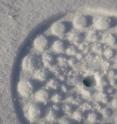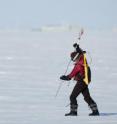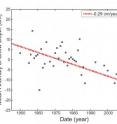Snow has thinned on Arctic sea ice
Related images
(click to enlarge)
From research stations drifting on ice floes to high-tech aircraft radar, scientists have been tracking the depth of snow that accumulates on Arctic sea ice for almost a century. Now that people are more concerned than ever about what is happening at the poles, research led by the University of Washington and NASA confirms that snow has thinned significantly in the Arctic, particularly on sea ice in western waters near Alaska. A new study, accepted for publication in the Journal of Geophysical Research: Oceans, a publication of the American Geophysical Union, combines data collected by ice buoys and NASA aircraft with historic data from ice floes staffed by Soviet scientists from the late 1950s through the early 1990s to track changes over decades.
Historically, Soviets on drifting sea ice used meter sticks and handwritten logs to record snow depth. Today, researchers on the ground use an automated probe similar to a ski pole to verify the accuracy of airborne measurements.
"When you stab it into the ground, the basket move up, and it records the distance between the magnet and the end of the probe," said first author Melinda Webster, a UW graduate student in oceanography. "You can take a lot of measurements very quickly. It's a pretty big difference from the Soviet field stations."
Webster verified the accuracy of airborne data taken during a March 15, 2012 NASA flight over the sea ice near Barrow, Alaska. The following day Webster followed the same track in minus 30-degree temperatures while stabbing through the snow every two to three steps.
The authors compared data from NASA airborne surveys, collected between 2009 and 2013, with U.S. Army Corps of Engineers buoys frozen into the sea ice, and earlier data from Soviet drifting ice stations in 1937 and from 1954 through 1991. Results showed that snowpack has thinned from 14 inches to 9 inches (35 cm to 22 cm) in the western Arctic, and from 13 inches to 6 inches (33 cm to 14.5 cm) in the Beaufort and Chukchi seas, west and north of Alaska.
That's a decline in the western Arctic of about a third, and snowpack in the Beaufort and Chukchi seas less than half as thick in spring in recent years compared to the average Soviet-era records for that time of year.
"Knowing exactly the error between the airborne and the ground measurements, we're able to say with confidence, Yes, the snow is decreasing in the Beaufort and Chukchi seas," said co-author Ignatius Rigor, an oceanographer at the UW's Applied Physics Laboratory.
The authors speculate the reason for the thinner snow, especially in the Beaufort and Chukchi seas, may be that the surface freeze-up is happening later in the fall so the year's heaviest snowfalls, in September and October, mostly fall into the open ocean.
What thinner snow will mean for the ice is not certain. Deeper snow actually shields ice from cold air, so a thinner blanket may allow the ice to grow thicker during the winter. On the other hand, thinner snow cover may allow the ice to melt earlier in the springtime.
Thinner snow has other effects, Webster said, for animals that use the snow to make dens, and for low-light microscopic plants that grow underneath the sea ice and form the base of the Arctic food web.
The new results support a 15-year-old UW-led study in which Russian and American scientists first analyzed the historic Arctic Ocean snow measurements. That paper detected a slight decline in spring snow depth that the authors believed, even then, was due to a shorter ice-covered season.
"This confirms and extends the results of that earlier work, showing that we continue to see thinning snow on the Arctic sea ice," said Rigor, who was also a co-author on the earlier paper.
The recent fieldwork was part of NASA's Operation IceBridge program, which is using aircraft to track changes while NASA prepares to launch a new ice-monitoring satellite in 2017. The team conducted research flights in spring 2012 as part of a larger program to monitor changes in the Arctic.
Source: University of Washington
Other sources
- Snow Cover on Arctic Sea Ice Has Thinned 30 to 50 Percentfrom NASA Jet Propulsion LaboratoryFri, 15 Aug 2014, 21:01:06 UTC
- Arctic's spring snow a third of what it was in 1950sfrom UPIThu, 14 Aug 2014, 18:00:54 UTC
- Thinning Arctic Snow Could Alter North Pole Ecosystemfrom Live ScienceThu, 14 Aug 2014, 12:00:27 UTC
- Snow has thinned on Arctic sea ice, study findsfrom Science DailyWed, 13 Aug 2014, 18:32:01 UTC
- Snow has thinned on Arctic sea icefrom PhysorgWed, 13 Aug 2014, 14:00:44 UTC


